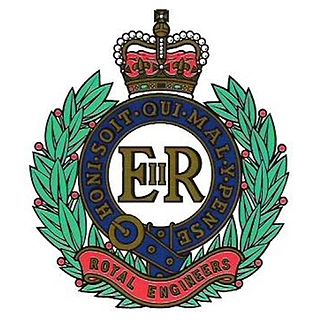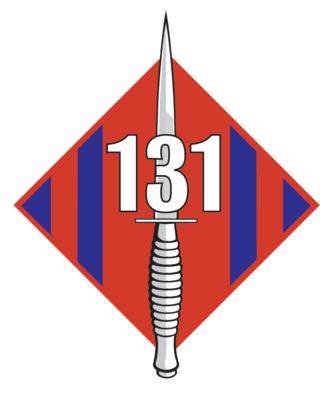
The Royal Corps of Signals is one of the combat support arms of the British Army. Signals units are among the first into action, providing the battlefield communications and information systems essential to all operations. Royal Signals units provide the full telecommunications infrastructure for the Army wherever they operate in the world. The Corps has its own engineers, logistics experts and systems operators to run radio and area networks in the field. It is responsible for installing, maintaining and operating all types of telecommunications equipment and information systems, providing command support to commanders and their headquarters, and conducting electronic warfare against enemy communications.
Options for Change was a restructuring of the British Armed Forces in summer 1990 after the end of the Cold War.

562 Parachute Squadron Royal Corps of Transport (Volunteers) was a minor unit that supported 44th Parachute Brigade (V).

9 Parachute Squadron RE is an airborne detachment of the Royal Engineers, part of the British Army. Like other units consisting of Royal Engineers, soldiers in the squadron are called sappers. It is part of the 23 Parachute Engineer Regiment based at Rock Barracks the airborne Royal Engineers unit.

131 Commando Squadron Royal Engineers is an Army Reserve unit and part of 24 Commando Regiment Royal Engineers. It provides engineering support to 3 Commando Brigade Royal Marines and is the largest Army Reserve Commando unit. The squadron has deployed worldwide to provide combat engineer support to 3 Cdo Bde RM, often deploying in small sub-units. 131 was first raised in 1947 as an airborne engineer regiment, and reached a strength of over 1,000 trained parachute engineers by the early 1960s. Between 1 April 1978 and 1 October 2015, the unit was an independent Commando squadron under operational command of HQ 3 Cdo Bde RM. On 2 October 2015, it formally became the third squadron of 24 Commando Engineer Regiment.
The 2nd Combat Engineer Regiment (2 CER) is an Australian Army combat engineer regiment located at Gallipoli Barracks in Brisbane, Queensland. It is part of the Australian 7th Brigade, attached to Forces Command (Australia).
5th Engineer Regiment is a Reserve unit of the Royal Australian Engineers. Originally raised as the "5th Combat Engineer Regiment" in 1995 from the 4th Field Engineer Regiment, it is based in Holsworthy, Sydney, with one of its sub-units based at the multi-user depot HMAS Harman, in Canberra and another at Orchard Hills and Dundas. Some of the unit's subunits draw lineage from the 4th and 5th Field Companies, which were raised for service during World War I.

23 Parachute Engineer Regiment is a Royal Engineers regiment in the British Army that was formed in 2003. It provides engineer support to 16 Air Assault Brigade in both the parachute and air assault role. The regiment is currently based at Rock Barracks in Suffolk and consists of three regular squadrons and one Army Reserve squadron. As part of 16 Air Assault Brigade it can be called upon to deploy on operations across the globe at extremely short notice.
The Northern Army Group (NORTHAG) was a NATO military formation comprising five Army Corps from five NATO member nations. During the Cold War NORTHAG was NATO's forward defence in the Northern half of the Federal Republic of Germany (FRG). The Southern half of the Federal Republic of Germany was to be defended by the four Army Corps of NATO's Central Army Group (CENTAG). During wartime NORTHAG would command four frontline corps and one reserve corps. Air support was provided by Second Allied Tactical Air Force.

The 21st Construction Regiment was a construction engineer regiment of the Australian Army Reserve. Part of the 5th Brigade, the regiment was formed in 1950 and was based in New South Wales where it provided support to the 2nd Division. The regiment has contributed personnel to a number of operations including the Regional Assistance Mission to the Solomon Islands, Operation Slipper and Operation Astute. It also regularly supported the Army Aboriginal Community Assistance Program and provided assistance to the Australian community in times of natural disaster. The regiment was disbanded in 2013.
The Tyne Electrical Engineers (TEE) is a Volunteer unit of the British Army that has existed under various titles since 1860. It has been the parent unit for a large number of units fulfilling specialist coastal and air defence roles in the Royal Engineers (RE) and Royal Artillery (RA), many seeing service during both World Wars. TEE companies currently form part of the RE and of the Royal Electrical and Mechanical Engineers in the Army Reserve.
The 1st Newcastle Engineer Volunteers, later Northumbrian Divisional Engineers, was a Royal Engineer (RE) unit of Britain's Volunteer Force and Territorial Army founded in 1860. Its companies saw action in both World Wars, particularly at the Battle of Rosières and the assault crossing of the River Selle in 1918, and on D-Day in 1944. Its successors continue to serve in today's Army Reserve.
71 Engineer Regiment is an Army Reserve regiment of the Royal Engineers, British Army. Its headquarters is at RAF Leuchars, Fife, and has units across Scotland, northern England and Northern Ireland. Its regular army paired unit is 39 Engineer Regiment, at Kinloss, Moray.
This is a list of units of the British Army's Royal Engineers.
The following is a hierarchical outline for the structure of the British Army in 1989. The most authoritative source for this type of information available is Ministry of Defence, Master Order of Battle, and United Kingdom Land Forces, HQ UKLF, UKLF ORBAT Review Action Plan, HQ UKLF, 1990.

The 29 Group, formerly 29 Engineer Brigade, is an engineer formation of the British Army responsible for Explosive Ordnance Disposal and Search. Its headquarters were at Aldershot, now at Didcot.
The 74th Engineer Regiment was a former Territorial Army regiment of the Royal Engineers, British Army. Initially the 74th Engineer Regiment was a reserve engineer regiment, but was then disbanded in 1994. An independent squadron remained. As part of Army 2020 the squadron moves to become part of the 71st Engineer Regiment.

299 Parachute Squadron, Royal Engineers is a specialist field engineer squadron of the British Army's Corps of Royal Engineers and the only reserve parachute unit of the corps. Formed in 1947 as an airborne field squadron, 299 Para Sqn would see many reorganisations and new roles, until 2006 when it took on the parachute role it maintains today. As of 2021, it is the only reserve parachute-trained squadron of the Royal Engineers.







